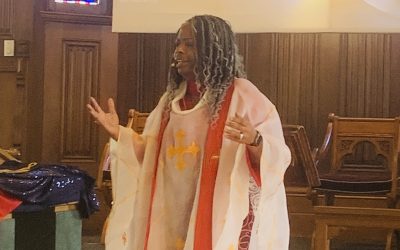The novelist and poet kick off the academic year
October 2024 – Writers@Drew kicked off the academic year by welcoming novelist Cleyvis Natera and poet Brenda Shaughnessy who presented readings from their work.
Natera read an excerpt from her novel Neruda on the Park, named a New York Times Editor’s Choice. Her fiction and criticism have appeared in such publications as The New York Times Book Review, The Washington Post, and The Kenyon Review. She received a 2024 Voices Rising Fellowship from the Vermont Studio Center as well as honors from PEN America, the Bread Loaf Writers’ Conference, and Disquiet International. She teaches Creative Writing and Spanish & Latino Studies at Montclair State University.
Shaughnessy is a recipient of a Literature Award from the American Academy of Arts and Letters, a Guggenheim Foundation Fellowship, and the James Laughlin Award. Her poems, interviews and essays have appeared in The New Yorker, Paris Review, Yale Review, and The New York Times Book Review. She is Professor of English and Creative Writing at Rutgers University-Newark.
Shaughnessy is the author of seven poetry collections. She shared poems from her newest collection, Tanya, as well as from The Octopus Museum.
The readings were followed by a Q&A discussion with the student audience, moderated by Associate Professor of English and Director of Drew’s Creative Writing Program, Courtney Zoffness.
One student asked how the authors use imagery and figurative language to appeal to multiple senses.
“I think that multisensory work in any form of prose is key,” answered Shaughnessy. “I think it’s an easy way for a writer to make that incredible leap to captivate another person’s psyche because they have senses too. Suddenly, we are literally on the same page—we have experienced the same physical thing, like the smell and taste of coffee.”
“I also have a visual sense of what things should look like in my work,” replied Natera. “I try not to hinder my own creativity on my first draft, I just want whatever is flowing to flow. When I revise, I revisit my toolbelt to ensure I have engaged every sense.”
Another student asked how the authors manage multiple themes in their work.
“Writing this book was a process of time for me that took 15 years from the beginning to publication,” said Natera. During this time, she explored the changes and growth occurring in her personal life and translated the experiences to the characters in her book. “All along I knew the back story, which became the front story, was gentrification in my [New York City] neighborhood,” she said.
“I’m a big fan of writing by hand and then I transfer my work to the computer,” said Shaughnessy. “Now I have two versions with two separate narratives. I don’t have a linear mind. Whatever is on my mind jumps into my poem. I can choose to edit later. The blank page itself is the biggest challenge for me.”
The authors were candid with their experiences when asked about their publishing journeys. “I had two failed novels that I worked on for decades,” shared Shaughnessy, whose editor of her first book of poetry dropped her abruptly. “It really crushed me,” she said. “I received rejection after rejection and felt humbled and desolate. My biggest dream was dashed.”
“But then someone took it,” she said, referring to an editor at a publishing house.
“I had three different agents,” said Natera, who also experienced a failed novel. “I was committed to being a novelist and very strict with myself,” she said, turning away opportunities to publish essays, short stories, and other smaller works. Now, she appreciates every offer to be published. “It’s so joyful to get a byline. If I had that throughout my publishing journey, I would have had more joy and less pain.”
“There are so many gatekeepers in publishing,” said Natera. “But once your book makes it through the gates, the book finds readers.”
The free event was co-sponsored by The Casement Fund, Drew’s English Department, and Drew’s Launch platform.



